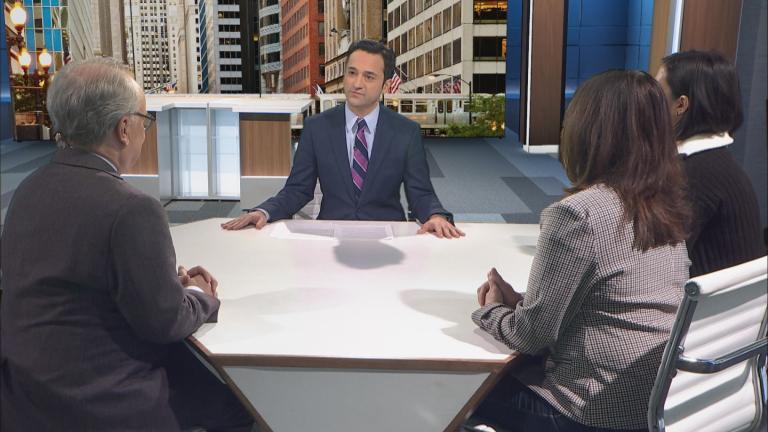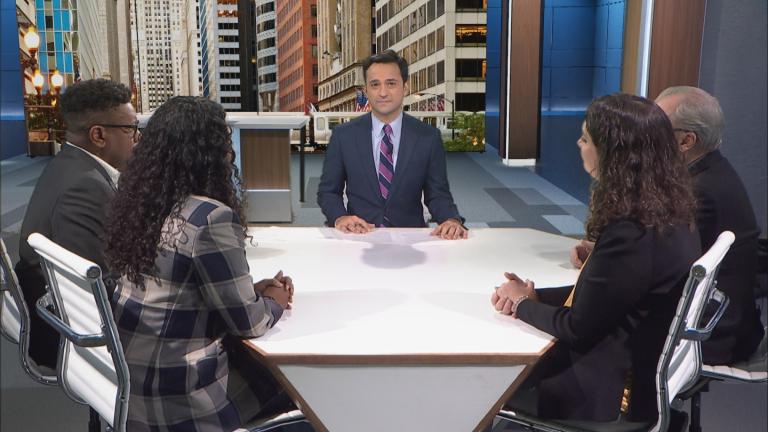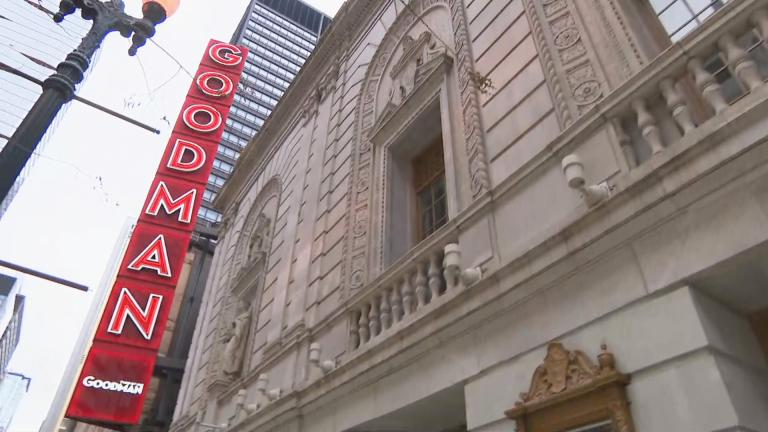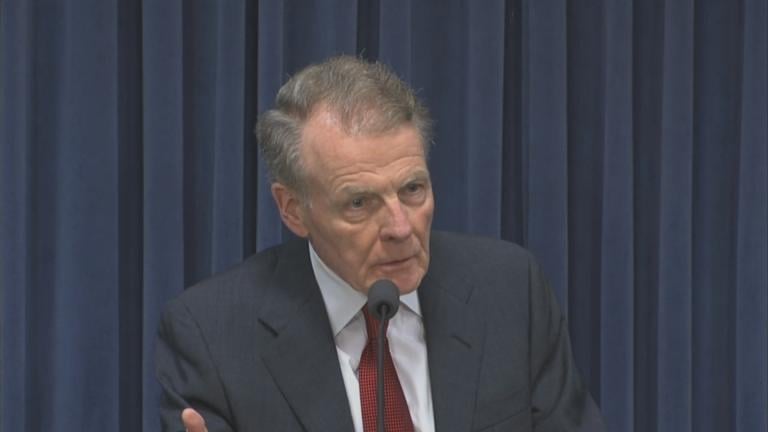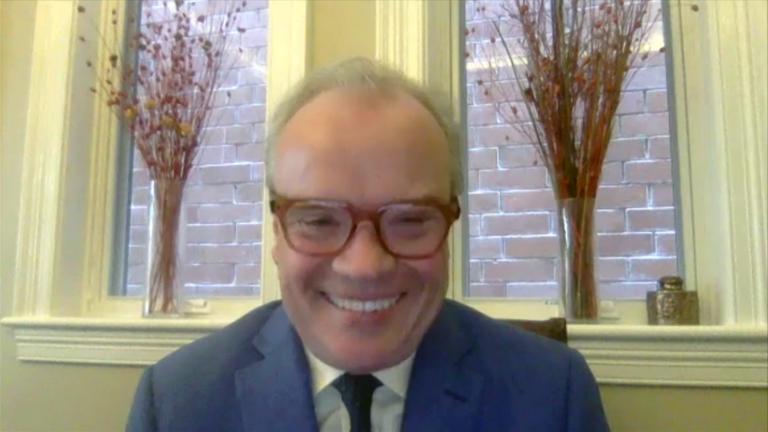Chicago Tribune theater critic Chris Jones joins us to talk about his new book, Bigger, Brighter, Louder: 150 Years of Chicago Theater as Seen by Chicago Tribune Critics. Read two excerpts from the book:
74
-----------------------------------------------------------------
AMERICAN BUFFALO
-----------------------------------------------------------------
‘BUFFALO’ ONLY FRAGMENTS OF THE INTENDEDGoodman Theatre
BY ROGER DETTMER
CAST
Donny Dubrow..................................... J. J. Johnston
Walter (“Teacher”) Cole................Bernard Erhard
Bobby.............................................William H. MacyOCTOBER 25, 1975. If Second City is currently shopping for local pretentions to parody in some future revue, a place to case on weekends
through Nov. 9 is the Ruth Page Auditorium at 1016 N. Dearborn St. The target there is “American Buffalo” (as in yesteryear’s nickels), which the Goodman Theater’s Stage 2 series produced as a play-in-progress on Thursday.Whether the author, young David Mamet, can organize almost two hours of bleep-rated dialog into a beginning, a middle, and an end is altogether more problematical. His Chicago setting for this undone essay on alienation is an Uptown resale shop owned by Donny Dubrow.
A sad dummy of a kid called Bobby, hooked on drugs, hangs around whenever he needs money, or Donny needs someone to burgle an unguarded
house. A second-story maggot nicknamed “Teacher” also hangs around, to play cards after closing hours, and maybe to muscle in on a heist.In one of Donny’s showcases, a coin collector spotted a Buffalo nickel and paid $90 for it. Figuring the guy for an easy mark, Donny has had Bobby bird-dog him until the fellow leaves his place “just around the corner” for a weekend.
When “Teacher” (“Teach” for short) gets wind of the action, he muscles out Bobby for a larger piece of the action. But Donny wants someone named Fletcher included over the protestations of “Teach.” Fletcher doesn’t show, though, at the appointed hour. In comes Bobby to say Fletcher got mugged; he heard about it from two dykes who sometimes play cards at Donny’s. And win, which emasculates “Teach,” in any case a bad loser.
Bobby has gotten the name of the hospital wrong. “Teach” begins an irrational interrogation, then hits the kid with a revolver butt. While Bobby bleeds, the phone rings and Donny learns that he was telling the truth. “Teach” is sent to get his car so that Bobby can be hospitalized. And the lights dim.
One can sense the direction in which Mamet wanted to go, although he hasn’t yet finished or polished his play. From a precocious philosopher in “The Duck Variations,” he has gone the inferential route of Harold Pinter. But “American Buffalo” suggests that Mamet listens in on conversations, like a fledgling Paddy Chayefsky. Pinter and Chayefsky, though, are irreconcilable. Polar opposites, in fact. And we come away with the feeling that Mamet writes dialog first, the characters to fit it, and lastly tries to relate them coherently and meaningfully.
But this hasn’t worked. Yet. William H. Macy as Bobby is the only winner in this production. Bernard Erhard is onto “Teach” but the role holds too many contradictions for any consistency of characterization. Since Mamet hasn’t even begun to solve Donny, J. J. Johnston is booby-trapped.
The machismo epithets of Uptown become tediously dirty (which they are in real life). But drama is a distillation of life, not mere eavesdropping. “American Buffalo” right now is about 20 usable minutes of a play that Mamet needs to edit, expand, enliven, and point in some direction.
Roger Dettmer was not an especially insightful theater critic, his skills in the music field notwithstanding. This first review of the world premiere of
“American Buffalo”—a short two-act, three-character play whose famous plot involves three interdependent men hatching a hapless plot to steal a coin collection from a former customer’s house—joins that undistinguished group of opening-night reviews of great plays by critics who completely missed the point. Mamet had taken “American Buffalo,” which would go on to win the Pulitzer Prize and earn a reputation as one of great contemporary American plays, to the Goodman Theatre, where Greg Mosher was directing its “Stage 2” series and was hungry for new scripts. William H. Macy was in the cast.Dettmer writes a pedestrian review, hung up on Mamet’s language and the play’s apparent resistance to a linear structure. About all he adequately
captures of Mamet’s skills is his felicity with language. He certainly smells no greatness in the air, no sense of how well the play captures the North Side of Chicago. He did not understand that this is a colorful and famously profane attack on the ethics of American business, as seen from the bottom of its food chain.The racy dialogue in “American Buffalo” certainly suggests that the Second City was still a strong influence on Mamet. But—not that you would have known it from this review—he also had carefully constructed a kind of surrogate family. Donny and Teach fight for the soul of young Bobby, who will do anything to please and who receives a mixture of placating dollar bills and admonishing blows to the head. In the character of Teach, Mamet had forged a recognizably American, even a recognizably Chicago type, a nasty fellow who smashes up his world, hurling junk, treasures and souls alike into some great slag heap of personal paranoia. But Teach is hardly an urban revolutionary, rather a low-grade loser whose tantrums will never amount to anything more than self-defeating deals and schemes. This is a work very much on a long Chicago trajectory. But Dettmer either couldn’t or wouldn’t make the link.
Glenna Syse, who was writing for the Sun-Times, didn’t like “American Buffalo” either. Only one critic loved the play and hailed it as a thrilling new work: Richard Christiansen, then writing for the Chicago Daily News. Soon he would move to the Tribune, where he would become the champion of the Steppenwolf Theatre Company.
But it would be Larry Kart who first trekked to the players’ famous Highland Park basement.
76
--------------------------------------------------------------
BLEACHER BUMS
---------------------------------------------------------------
‘BLEACHER BUMS’ ENDEARINGOrganic Theater Company
Leo Lerner TheaterBY LINDA WINER
AUGUST 3, 1977. There are hot dogs, bottled beer, popcorn, baseball, gambling compulsions, winner-loser obsessions, and team fanaticisms
for all in “Bleacher Bums,” an extended Organic Theater sketch which opened Tuesday at the Leo Lerner Theater in Uptown.Since I don’t care about any of the above, except maybe popcorn and I wouldn’t cross a wide alley for that, and since the national pastime has never been mine, and since all Wrigley Field ever symbolized to me was traffic congestion on Addison Street, consider: If I like “Bleacher Bums,” anybody could.
And I liked it a lot. Eight virtually topnotch Organic character actors have improvised an endearing “nine-inning comedy,” conceived from within by the cast’s Joe Mantegna; directed by Stuart Gordon, with additional dialogue by Dennis Paoli, and additional atmosphere by the audience, munching with ballpark dedication around three sides of the theater’s shifted arena.
The whole thing takes 90 minutes, with no intermission but a real seventh-inning stretch. The messages are hardly profound, but the caricatures have moments of truth beneath their role playing.
This is an emotional push-over of a play, as much about faith, enthusiasm, fantasy, and ritual as about Cubs fans at the game.
The maligned wife gets vindicated—and a bit patronized?—as a baseball sharpie. The likable blind man with the transistor radio gets the busty blond. The slow-witted fellow gets defended, and everybody comes out to protect the hyperkinetic kid bouncing ethics for team frenzy. The comedy almost gets serious about problem gambling, then, perhaps unfortunately, shies away from dampening the opportunity for baseball bonanza.
A cram course in last week’s Tribune series by Bob Logan tells us that the original Bleacher Bums started as pitcher Dick Selma’s cheering squad during the team’s last winning streak in 1969, then turned sour, and distinguished itself by burning down Chief Nok-A-Homa’s tepee during a trip to Atlanta for a game.
The authenticity of the Organic’s current view of rabid Cubs fans escapes my innocence. But Gordon has directed the ensemble with even more of his usual high energy, deftly controlled in the limited space of the bleacher benches.
The cast, which apparently costumed itself in ideal clothing details, has turned out a script with none of the problems the Organic often has with its texts. Forget Kurt Vonnegut. It works when the Organic writes itself.
Michael Saad is especially wonderful as the blind fellow with more than terrific hearing, though one should not single out any one in such a tuned ensemble that includes Mantegna, Carolyn Purdy-Gordon, Dennis Franz, Ian Williams, Richard Fire, Keith Szarabajka, and Roberta Custer. They make—and are—the show.
The Organic, no dummy, has itself a perfect little summer show that capitalizes on the current baseball fever while Gordon wrestles with fund raising and remodeling of their new, bigger Buckingham Theater further south on Clark Street. Their only danger now is a flub from the Cubs.
Linda Winer is quite the stylist here, managing to parse her confessed lack of interest in baseball into a primary qualification for reviewing the show: “If I like ‘Bleacher Bums,’ anybody could.”
And like it they did. “Bleacher Bums” was one of the most famous productions at the Organic Theater, ideal for a company always composed of real actors rather than pretty faces. It was, in essence, an attempt to cash in on the loyal fans of the Chicago Cubs; the populists at the Organic were trying to get some of the hordes populating the bleachers at Wrigley Field to actually walk into the theater, and they figured that the best way to tempt these fans was to show them characters just like them. “I lived right by Wrigley Field back then,” Joe Mantegna recalled in an interview years later. “I used to watch the people stream out of the ballpark and I’d try and figure out how we could possibly get all of those people into our theater.”
“Our homework,” noted Dennis Franz in that same Tribune story, “was to go to Wrigley and search the stands for interesting people. We infiltrated them. We took pictures without their knowing it. We befriended them. Then we headed back to the theater, listened to the tape and looked at the photographs, and created a fictitious identity surrounding their lives. We had to alter the names slightly. The aim was to represent the heart of the Cubs fans, the poor souls whose one thing in common is to root for this unfortunate team that breaks their hearts year after year after year.”
“Bleacher Bums” ran for about 2 years and subsequently played all over the country, including a whopping 13 years in Los Angeles.
The show was revived in 1978 and again in 1989, with the later production directed by Mantegna himself. A movie was made for the Showtime cable network in 2001, but Major League Baseball wouldn’t allow the script to mention either Wrigley Field or the Cubs (Mantegna has said that the baseball league did not approve of the play’s copious references to gambling in the bleachers).
In 2004, during a brief period of resurgence for the Chicago Cubs, a new commercial production of “Bleacher Bums” was staged at the Royal George Theatre, with Gary Sandy playing the role originated by Mantegna (who was an investor in the show). This “Bleacher Bums” was modestly successful, but the material proved dated, even though Carolyn Purdy-Gordon and the others had “updated” the show to reflect the current Cubs roster.
Winer nailed the show in 1977, essentially calling it an “extended sketch” with a bleeding heart. It has caught what it is to be a Cubs fan better than any other show before or since.
But what of the South Side of Chicago? By 1977, it, too, had a hefty piece of the theatrical action.
You are reading copyrighted material published by University of Chicago Press. Unauthorized posting, copying, or distributing of this work except as permitted under U.S. copyright law is illegal and injures the author and publisher. All articles originally appeared in the Chicago Tribune and are reprinted here with permission.


